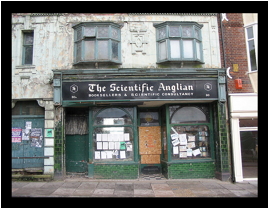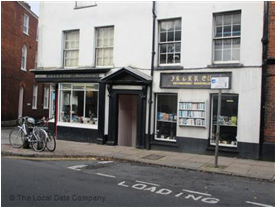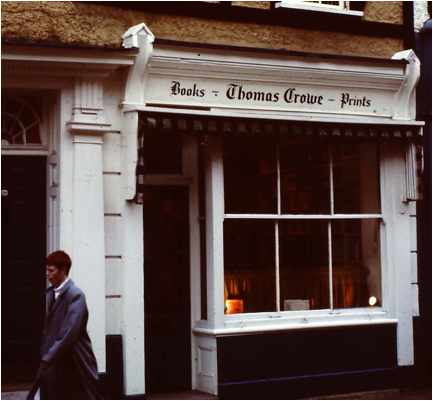NORWICH BOOK SHOPS
My first Norwich purchases were made at the University Book Shop from a lackluster stock. Studying Victorian Illustrated books, it was easier to doff the Gown and head Downtown to the wide range of book and print sellers.
1. Norman Peake and the Scientific Anglian.

Coming to give a lecture at the Norwich School of Art, Eduardo Paolozzi was 15 minutes late getting back from lunch. Sorry, he said, I had to get to Smelly Peake’s. Paolozzi brought out a copy of Kipling’s Captains Courageous but actually wanted to renew acquaintance with the owner of the Scientific Anglian bookshop, St.Benedicts Street, Norman Peake. Norman had been a Geologist, I was told. In a glorious fit of passion, he had tried to buy every Geology book in East Anglia. Finding himself with a warehouse of unsellable books, he started the Scientific Anglian, a sort of approximation of his original intentions. There is an account from Peake’s own lips in Jeremy Tod’s essay The Scientific Anglian for the Crewative Writing Course at the University of East Anglia.from Body of Work: 40 Years of Creative Writing at UEA Full Circle)
But nothing there can convey the eccentricity of the man. He was pitted with book dust, grime and the pickings of gutta percha. He itched himself on a regular basis, concentrating much of the time on his buttocks. He was utterly unselfconscious and could construct complex (if baffling arguments) while digging robustly with a digit. Tod describes the complex assemblage of inanimate objects with which he surrounded himself. I would only the diagram of a wartime bandage diagram in a triangular space as you go down to the basement floor. So neat a placement and not for sale. The ground floor had a sort of back room from which occasionally customers were banned, adding to the lure of the stock. I still have books I bought from Norman, his pricing in biro engraved at the top right hand corner of the front endpaper. The numbers were contained with a drawn square that transmitted its impression at least eight pages into the book. He feared buying the book back, I suspect.
At one stage he entered into partnership with the bravest woman ever to enter the Book Trade called Grace who tried to set the business on a steady track while concentrating the mind of Norman Peake. Later she emerged in a Wymondham Bookshop seemingly none the worse, but her memories of the Scientific Anglian would have been fascinating.
It is unsurprising that such a shop attracted an appropriately dippy class of customer. Celebrated was the Poetic Vicar who talked entirely in rhymed couplets about himself and his book buying.
“Once I met my friend Dolores here
With plastic mac and tresses sheer
She loved her books on Thomas Browne
And read his essays over Town…”
He could keep this up for the natural length of a conversation with no difficulty and enthrall the customers. As Tod records at the end of his essay, the shop is now a Men’s Outfitters, so often the fate of the Last Bastion of Literacy.
2. John and Kay Ellis

In my dreams I have never visited Norman’s shop. There is something too forbidding about it. I think I always knew where the door was in case a sudden evacuation was called for. The other two major bookshops feature regularly in my dreams, not in narrative terms but in spatial terms.
I adored John and Kaye Ellis, both ex-Royal College, and imbued with delightful art school values. While my colleagues favoured the Red Lion at lunchtimes, I loved the run through the Norwich Market place, taking in Geoff Ives second hand record shop. Next stop was Ellis’s Book Shop, then to Upper St Giles and Russell Crowe’s shop on the corner, and the Daddy Shop, Thomas Crowe’s shop next to Russell. John Ellis had a way of talking out of the side of his mouth and winking at the mischief and gossip. If you went through the pedimented doorway, quality books at a higher price were in a small shelf unit in the hallway, where they enjoyed greater visibility. How many times have I dreams sauntered past these shelves and chased some spectre into the main room. Here Kaye told me about the Charlie Bar, used in cinematography, an iron contraption that casts a shadow across the chest of an actor whom the director felt was too flat chested.
Being superstitious with the layout of book shops, I preferred to go into the shop through the door on the corner, passing the window shelves and stepping down into the shop. Straight ahead was the long pew on which recent acquisitions were laid out horizontally. Here I bought a row of Wyndham Lewis novels, and the 2 volume Magazine of the Wandsworth Hospital with reproductions of C.R.W.Nevinson woodcuts.
Sometimes in dreams I am at the Art School, and wading through slush in my slippers I am trying to find the Ellis frontage, but find myself perversely down by the Cathedral. Not once have I ever entered the shop in dreams. Going back to Norwich and giving a paper at a Conference on Nigel Henderson, I think I annoyed the organizer Linda then Checketts by legging it after my talk and trying to get to the Ellis’ shop before closing.
Oriole and I went back years later, and John recognized me at once.”Clogs!” he exclaimed. I used to wear large white clogs in my early years. We were taken through to a back living room and there was Kaye dozing by the fire. I thought she looked older, and perhaps sick. It was great to see them both, with Robert and the other kids (who run the place to this day).
3. Tom Crowe, Peter Crowe and Russell Crowe.

The first proper shop I encountered was Thomas Crowe, Books and Prints. Through the door you could go left or right, and the stairs took you to an upper story, which for a reason figures regularly in my dreams. One morning I found a carpenter removing a large bookcase from the left hand room wall to reveal a small shelved room behind it. What fascination. The books were dull and worthless but the very idea thrilled.
Thomas Crowe was the sturdy courtly boss of the firm, always seemingly standing near the large framed Searle Caricature of the Average Second Hand book dealer. I was delighted at getting all four volumes of the first edition of Lavater’s Physiognomy for five pounds and must have signaled I should have been charged more. “I am not a greedy man!” said Thomas Crowe. There was a back office but the door was always firmly shut.
One of my University pals lived opposite and from her upper floor window I could watch comings and goings, parcels and late lunches.